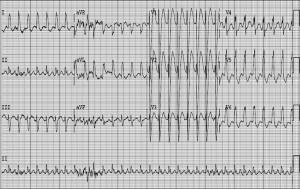This is a fictitious patient seen at a fictitious hospital called Janus General. Don’t believe me? I’m on staff there – see
After seeing your 44th URI of the day in the Peds ER, you get a call on the batphone – a 4 year old female, altered mental status, eta 4 minutes. You prep the resus room and assign roles.
On arrival, the patient begins to have a tonic-clonic seizure. Per broselow tape, you give the correct dose of IM midazolam with resolution of the seizure.
CC: AMS now with generalized tonic-clonic seizure
HPI: 4 year old female, no past medical history was found on bathroom floor. The medicine cabinet was open with pill bottles scattered on ground, many open. Mom and Dad together take medication for HTN, DM, and CHF but do not know the medications’ names. Sister takes allergy medicine, sleeping medicine, and OCPs. The cabinet has the usual over-the-counter medications (motrin or tylenol or both, itching medicine pills, neosporin, vitamins) as well.
ROS fully negative prior to being found down.
VS HR 180 (and appears WIDE!), RR 15, BP 140/70, Rectal Temp 98.5, O2stat 100% on NRB.
PE: Child is responsive to touch, groans, PERRL, moves all 4 extremities, warm skin, dry MM, +gag, heart/lung/abdomen exam unremarkable.
EKG
1. Please provide a thorough differential including leading diagnosis.
2. Please provide a brief summary of appropriate management for your top diagnosis and/or for the patient.
By Dr. Andrew Grock
Special thanks to Dr. Khadpe for his invaluable feedback on the Case of the Month episodes #1 and #2.
andygrock
- Resident Editor In Chief of blog.clinicalmonster.com.
- Co-Founder and Co-Director of the ALiEM AIR Executive Board - Check it out here: http://www.aliem.com/aliem-approved-instructional-resources-air-series/
- Resident at Kings County Hospital
Latest posts by andygrock (see all)
- A Tox Mystery…. - May 26, 2015
- Of Course, US Only for Kidney Stones… - May 18, 2015
- Case of the Month 11: Answer - May 12, 2015
- Too Classic a Question to Be Bored Review - May 5, 2015
- Case of the Month 11: Presentation - May 1, 2015


The patient was found down near open pill bottles making poisoning the most likely diagnosis.
The patient has altered mental status, seizures, metabolic acidosis with an anion gap of 14, tachycardia, and low potassium. The most likely intoxication is aspirin overdose. If this is the case, her acidosis is an ominous sign because the protonated form of acetylsalicylic acid can cross the blood brain barrier and enter the CNS more readily than the ionized form. The patient should be intubated quickly by someone who is experienced (failed attempts would exacerbate the acidosis due to increasing CO2) and then she should be hyperventilated – respiratory alkalosis is therapeutic here. Since this looks like an acute intoxication, gastric lavage with activated charcoal is not unreasonable. The patient should also be given D50 because although her glucose is within normal range, aspirin is a mitochondrial toxin and so she needs a higher glucose concentration for her CNS mitochondria to function. Since she has seizures in the setting of aspirin OD, emergency hemodialysis is reasonable as well. She needs an ICU setting and Dr. Weiner should be paged.
Other possibilities:
Dig toxicity (low potassium makes this less likely plus the classic arrhythmia of dig toxicity is ventricular brady with atrial tachy due to increased automaticity and decreased conduction. Other arrhythmias are very possible with dig though).
Sulfonylurea toxicity (unlikely with normal glucose, but seizures and AMS could be due to hypoglycemia after ingestion of insulin secretogogue)
Metformin toxicity (she has a high lactate, history of renal disease uncertain)
Head trauma (she could have fallen reaching for the pills, hit her head-> AMS + seizure)
Meningitis/encephalitis (URIs everywhere, maybe she felt sick and wanted motrin to feel better)
*anion gap 26
could be iron toxicity as well, ferritin level and abdominal xrays would help diagnose